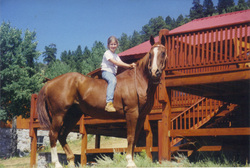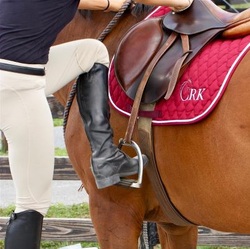Think of the riders you know who appear absolutely effortless on the back of a horse.
When they are riding, you can’t even see what they are asking their horse to do.
It looks like the horse is just responding to the rider’s thoughts… and from the rider’s perspective, it can feel like this too. What creates the ability to communicate with these subtle cues?
We all want to be light with our horses and we want to achieve the ideal of having invisible aids, but how does it really happen?
In today’s video and article, we are going to explore this question.
The first answer to invisible aids is through a process called fading. Fading means that we can make our cue or our request for something more and more subtle.
Let’s take an example of a teaching basic steering to a young horse. When we are first working with that horse, we are going to be using the cue of the movement of our body, but we may also be using a big opening inside rein.
As training progresses, we are going to use less and less of that opening rein to guide the horse and they will learn to move just off the cue from our body.
For us as the riders, there is also a process of increasing skill that leads to more subtle cues. Good movement is a process of slowly eliminating all the excess.
If you are just learning to ride, there will be times where you feel like you lose your center and need to catch your balance.
As you get better and better at your riding, you’ll be able to just do the necessary movements. This is what we are seeing when we watch riders that look so still and poised on the horse, but yet they are very soft.
When we are controlled in our movements, and there is not a whole lot of excess there, it only takes the smallest movement, even one that is triggered by a thought to cue the horse for what we are thinking and what’s coming next.
Another piece of rider skill is being able to pick up on changes from the horse, even the smallest changes in the horse’s balance, in their rhythm, in their strides. Think of a horse that tends to drift and lean in around turns. One person might ride that horse and it will look like they are hardly working to keep them on the rail, but then another person rides and the horse is careening to the inside.
What makes the difference here is that the rider who is able to easily keep the horse on the rail is picking up on when the horse is first starting to think about drifting in. There is a small change of balance from the horse and the rider gives a subtle cue to straighten them out. It might be just closing their fingers on the outside rein. It might be a little bit of tightening on their inside leg. To someone watching it could look as though nothing happened.
The better you become at noticing the changes in your horse, then you can ask for corrections more quickly and with more subtlety.
Think of developing subtle cues in three parts. First is teaching the horse and then fading the cue.
Second is becoming more stable in our own balance so that we do not have a lot of excess movements and our cues can be very small and precise.
Third is being able to notice the smallest shifts in the horse and asking for a needed correction in balance before the horse is very unbalanced and is either going much faster, or falling in one direction or the other.
After you watch the video below, leave a comment with one cue that you would like to become more subtle between you and your horse.
If you would like to learn more about how to become a more stable, balanced, and effective rider, specific exercises that you can work on at home and with your horse then Click Here to join in on the Free Workshop from the Balanced Riding Course!














18 Responses
I’m getting part 4 of 7 on my iPhone but getting a blank screen. I will try the videos on my Mac. Could be a download problem or too big of a file.
I am using Winston, a therapy horse for PTSD and arthritis. I have not begun
to ride yet. I am brushing him and learning to walk alongside him
which is a challenge sometimes. I think trust is developing. I chose Winston because he was comical in his behavior towards me. I learned that though horses do not exhibit a visible expression, there is much feeling towards you. I think riding, really walking him, will begin to exercise muscles essential towards me feeling good and having more mobility. I would love to hear how CRK Training thinks of this as therapy from a horse. I will see him 12/4/19 since he is in Amity, a town upstate from surburban NYC.
Thanks
Hi Michael, are you looking for the Understanding Your Horse Series? I can better help you if you send an email to [email protected]! Simply being the with horse by spending time together by grooming and being on the ground is definitely a form of equine therapy.
-Julia Burdy, CRK Training Community Manager
The halt! My horse does not halt lol! I try to give her a heads up, use my seat, etc but our halt is really ugly. I end up yelling WHOA and even that has limited success. Definitely not subtle lol!
I have a wonderful pony that I can teach 5 year old children to ride. He goes forward easily and seems to read my mind as I’m teaching. However, students are unable to get him to halt. He fights and just keeps on going forward! So, I get on him and his halt is perfect, flawless!!! It’s all in the timing and feel. My contact is (of course) better than my students and my “ask” is gentle using my whole body (which takes time and experience to learn). The nano-second he stops walking he gets a soft release of the rein. This didn’t happen overnight! Obviously, I don’t know you or your horse so my suggestions may be redundant for you. When you ask for the halt, remember that important release. He may stop for only half a second and then be off again. Don’t wait for his feet to start moving, as you feel his body start that forward movement, catch it again, then release. Do it as many times as it’s necessary to get a full stop that will last a few seconds. Don’t bore him with the lesson but do it every time you ride. Eventually, he’ll learn and your halts will get softer and longer. Good luck! (I wonder if Callie will agree with me?)
Karen, the halt is actually something that can work well to begin teaching from the ground! You can also incorporate some positive reinforcement training to sweeten the deal 🙂 I would also recommend checking the saddle fit, sometimes if the horse is uncomfortable we can be ‘screaming’ at them with our aids and the discomfort can mute our cues!
-Julia Burdy, CRK Training Community Manager
Asking to pick up the canter. I ride a lot of lesson horses and getting some of them to canter can be difficult for me.
Cyndie, that is a tough one! Everyone also teaches asking for the canter a little bit differently…but we do have a video on riding the effortless canter transition you can watch by clicking here to get some tips!
-Julia Burdy, CRK Training Community Manager
Thank you. Those were helpful tips I’ll try!
Hi, Callie
I consider myself an intermediate rider because I have only ridden about 60 hours, in 4 1/2 years. I am still learning. I now only do trail rides because everything else is boring. I have had a lesson horse who was fairly sensitive, and would steer from the simple weight of the reins on his neck (no pulling, etc.). I thought he was great. Then I rode a horse (first time) who I could steer simply by thinking about it! No reins action, no conscious foot or leg pressure, but he (Happy Jack) would do a zig-zag course simply by me “willing” it. A marvelous animal, who I have never met the equal of since then. So I think at least part of the process can simply be the horse. Sadly, he was sold to someone far away.
Ray G.
Ray, I really like that you brought up this discussion because certain horses are VERY sensitive to our aids! This actually reminds me of my rides over the weekend, my sister-in-law just started riding and she has been on my two horses. One of which is very sensitive to the steering aids, the other is considerably less sensitive and she has the tendency to want to oversteer and it was better to have her learn on the less sensitive horse until she gets a better understanding of how best to apply the aids!
-Julia Burdy, CRK Training Community Manager
What to do if the horse won’t trot? The horse I am currently riding will walk and canter on the most subtle cue, canter from walk or stand still without any problem but when I ask for trot she will just ignore me. I can tell her to trot for like a minute, and then I get a really slow jog, so I ask her to go a little faster and she will just stop and we have to start all over again. I think when she is asked to “work” it’s usually in trot so she has learned to avoid it maybe.
Hi Klara! It sounds like from your description that maybe this horse has an easier time popping into the canter rather than pushing into a bigger trot. Did you watch last week’s video about leg cues? I would start by just working within the trot as much as you can getting a slightly longer stride for a few strides then back to the jog and continuing like that to help build the muscles and patterns for a bigger trot.
It sounds like from your comment that this might not be your horse, but it could be a discomfort issue possibly from saddle fit or a lameness presenting itself…just a thought to consider!
-Julia Burdy, CRK Training Community Manager
wonderful video, just what I needed to hear.
Glad you enjoyed the video Robyn 🙂
– Julia Burdy, CRK Training Community Manager
I really enjoyed the video on secrets concerning invisible aids. I’m asking several of my older students to watch it and I plan to work with them. Thank you so much.
So glad to hear you enjoyed that video Patti – and thanks for sharing with your students!
-Julia Burdy, CRK Training Community Manager
Getting my lesson horse to slow to a walk instead of stopping completely! I am trying to ‘stop trotting’ so that she does too, but we completely stop. How to ease that into a walk? And I apologize for this late comment, but I continually find new nuggets of wisdom (new videos) that I previously missed.
Hi Barb! No need to apologize for the late comment – we’re glad to have you here! I would recommend watching our video on Slowing Down a Fast Trot, you can use the same ideas for trot to walk transitions as well.
-Julia, CRK Training Community Manager